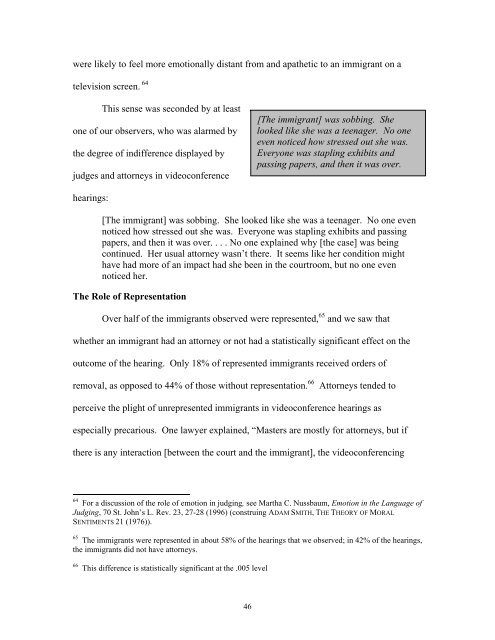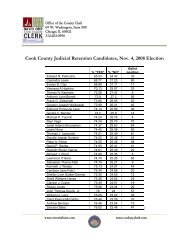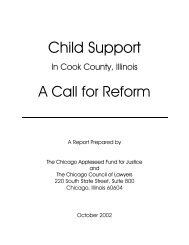Videoconferencing in Removal Hearings: A Case Study of the ...
Videoconferencing in Removal Hearings: A Case Study of the ...
Videoconferencing in Removal Hearings: A Case Study of the ...
Create successful ePaper yourself
Turn your PDF publications into a flip-book with our unique Google optimized e-Paper software.
were likely to feel more emotionally distant from and apa<strong>the</strong>tic to an immigrant on a<br />
television screen. 64<br />
This sense was seconded by at least<br />
one <strong>of</strong> our observers, who was alarmed by<br />
<strong>the</strong> degree <strong>of</strong> <strong>in</strong>difference displayed by<br />
judges and attorneys <strong>in</strong> videoconference<br />
hear<strong>in</strong>gs:<br />
46<br />
[The immigrant] was sobb<strong>in</strong>g. She<br />
looked like she was a teenager. No one<br />
even noticed how stressed out she was.<br />
Everyone was stapl<strong>in</strong>g exhibits and<br />
pass<strong>in</strong>g papers, and <strong>the</strong>n it was over.<br />
[The immigrant] was sobb<strong>in</strong>g. She looked like she was a teenager. No one even<br />
noticed how stressed out she was. Everyone was stapl<strong>in</strong>g exhibits and pass<strong>in</strong>g<br />
papers, and <strong>the</strong>n it was over. . . . No one expla<strong>in</strong>ed why [<strong>the</strong> case] was be<strong>in</strong>g<br />
cont<strong>in</strong>ued. Her usual attorney wasn’t <strong>the</strong>re. It seems like her condition might<br />
have had more <strong>of</strong> an impact had she been <strong>in</strong> <strong>the</strong> courtroom, but no one even<br />
noticed her.<br />
The Role <strong>of</strong> Representation<br />
Over half <strong>of</strong> <strong>the</strong> immigrants observed were represented, 65 and we saw that<br />
whe<strong>the</strong>r an immigrant had an attorney or not had a statistically significant effect on <strong>the</strong><br />
outcome <strong>of</strong> <strong>the</strong> hear<strong>in</strong>g. Only 18% <strong>of</strong> represented immigrants received orders <strong>of</strong><br />
removal, as opposed to 44% <strong>of</strong> those without representation. 66 Attorneys tended to<br />
perceive <strong>the</strong> plight <strong>of</strong> unrepresented immigrants <strong>in</strong> videoconference hear<strong>in</strong>gs as<br />
especially precarious. One lawyer expla<strong>in</strong>ed, “Masters are mostly for attorneys, but if<br />
<strong>the</strong>re is any <strong>in</strong>teraction [between <strong>the</strong> court and <strong>the</strong> immigrant], <strong>the</strong> videoconferenc<strong>in</strong>g<br />
64 For a discussion <strong>of</strong> <strong>the</strong> role <strong>of</strong> emotion <strong>in</strong> judg<strong>in</strong>g, see Martha C. Nussbaum, Emotion <strong>in</strong> <strong>the</strong> Language <strong>of</strong><br />
Judg<strong>in</strong>g, 70 St. John’s L. Rev. 23, 27-28 (1996) (constru<strong>in</strong>g ADAM SMITH, THE THEORY OF MORAL<br />
SENTIMENTS 21 (1976)).<br />
65<br />
The immigrants were represented <strong>in</strong> about 58% <strong>of</strong> <strong>the</strong> hear<strong>in</strong>gs that we observed; <strong>in</strong> 42% <strong>of</strong> <strong>the</strong> hear<strong>in</strong>gs,<br />
<strong>the</strong> immigrants did not have attorneys.<br />
66 This difference is statistically significant at <strong>the</strong> .005 level




